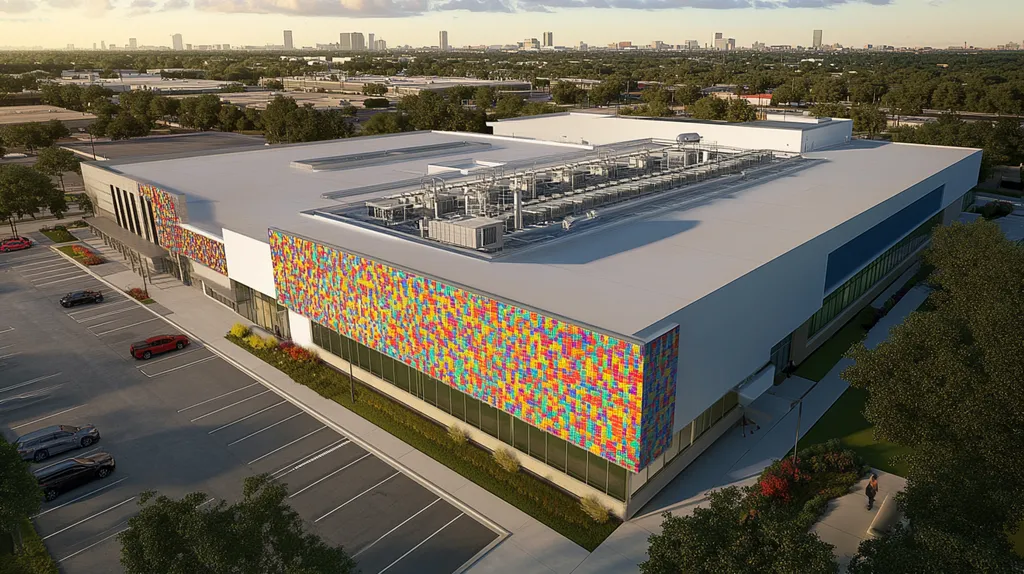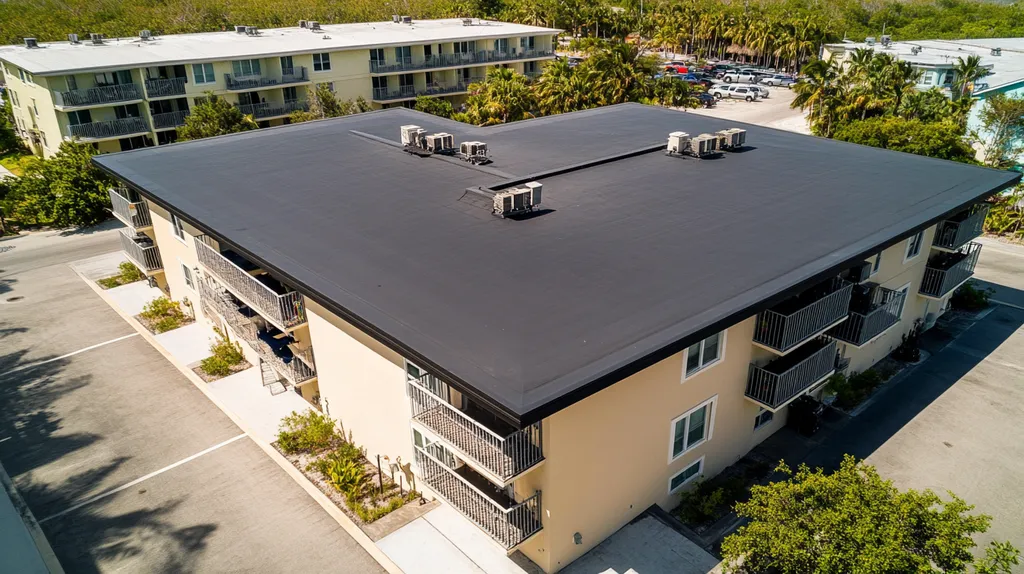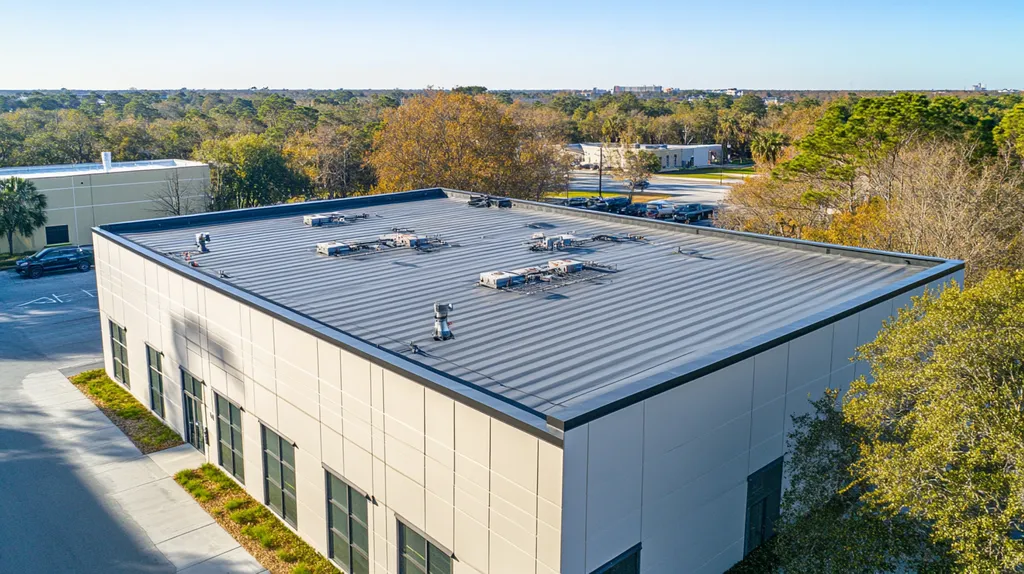The industrial roofing sector generates over 11 million tons of waste annually, yet standard cost assumptions about recycling continue to drive unsustainable disposal practices.
While recycling offers clear environmental and economic benefits, with potential savings of 20-30% on disposal costs, less than 15% of industrial roofing materials are currently recycled.
From inefficient sorting processes to limited recycling infrastructure, multiple systemic barriers inflate perceived costs and discourage widespread adoption of sustainable practices.
Understanding these challenges – and the opportunities they present – is crucial for property owners and facility managers seeking to make informed decisions about roofing waste management.
SECTION 1: CURRENT PRACTICES
The pressing need for sustainable roofing solutions is often overshadowed by the overwhelming reliance on landfill disposal. In the United States alone, over 11 million tons of roofing materials are disposed of in landfills each year. This practice not only depletes vital environmental resources but also overlooks the significant value that recycled materials can offer. For property owners and facility managers, recognizing the limitations of current disposal methods is vital, especially as these practices contribute to escalating costs.
Landfill Disposal Dominance
Currently, landfill disposal is the go-to method for managing old industrial roofing. Property owners often opt for this route, primarily due to its perceived convenience and a general unawareness of available alternatives. As a result, materials such as TPO, EPDM, and PVC are frequently sent directly to landfills.
This trend not only exacerbates the problem of overcrowded landfills but also neglects valuable opportunities for material recovery. As costs associated with landfill space continue to rise, local waste management systems find themselves under increasing pressure.
The ongoing reliance on landfill disposal reveals both a significant lack of recycling infrastructure and an entrenched mentality within the industry. While this choice may seem straightforward, it carries profound consequences, including environmental degradation and the loss of reusable materials.
To foster a more sustainable future, there is an urgent need to pivot towards recycling. Emphasizing this shift could unlock a wealth of environmentally friendly practices that benefit both businesses and the planet.
Limited Recycling Infrastructure
The current recycling infrastructure for roofing materials is significantly lacking. Many regions do not have the necessary facilities to process roofing waste efficiently. Even where recycling is available, logistical hurdles often complicate collection and transportation.
In some areas, entire states lack designated recycling centers for roofing materials, leaving property owners with no choice but to resort to landfill disposal, despite a growing commitment to environmental stewardship.
This gap between potential and reality results in persistently low recycling rates for roofing materials. Stakeholders in the industry are often frustrated knowing viable sustainable alternatives exist yet remain underutilized.
Enhancing the recycling infrastructure could address these challenges and promote a more eco-friendly roofing sector. Such investments would offer property owners and managers more responsible disposal options, facilitating a collective shift toward sustainability.
High Tipping Fees
High tipping fees pose a significant barrier for property owners contemplating recycling rather than disposal. The cost of disposing of roofing materials in landfills is on the rise, driven by increasing demand for limited landfill space.
These escalating fees deter property managers from pursuing responsible disposal options. In various regions, tipping fees can soar between $50 to $150 per ton, adding heft to the financial burden of roofing projects. Faced with these costs, many property owners find conventional disposal to be less daunting despite its drawbacks.
While recycling could help alleviate some of these expenses, the initial investment required for recycling services can be challenging. Without clearly defined pathways for recycling, property owners are left balancing immediate disposal costs against the long-term benefits of recycling.
Effectively addressing high tipping fees is crucial for encouraging interest in recycling options within the industrial roofing industry. Lowering disposal costs could create a powerful incentive, motivating property owners to adopt more sustainable practices.
SECTION 2: SYSTEMIC ISSUES
The journey toward recycling old industrial roofing materials is riddled with challenges that extend far beyond costs. One pressing issue is inefficient material sorting, which not only leads to wasted resources but also drives up disposal expenses and diminishes potential savings. Alarmingly, studies show that less than 20% of roofing materials are properly sorted for recycling, resulting in both financial loss and environmental harm. For property owners and facility managers, grasping these systemic issues is essential to making smarter roofing choices.
Inefficient Material Sorting
A significant challenge in the industrial roofing sector is the ineffective sorting of recyclable materials. When sorting practices fall short, valuable components like metal and membrane are mistakenly sent to waste. This mismanagement not only inflates disposal expenses but also undermines the advantages of recycling.
Poor training for workers handling the recycling process contributes to this inefficiency. Many employees lack the knowledge to identify recyclable materials, resulting in high volumes of improperly sorted waste. Research indicates that improved training can boost recycling rates by up to 35%.
Moreover, the limited availability of straightforward information regarding recyclable materials adds to the confusion. When workers are unsure about what can be recycled, they often err on the side of caution, leading to greater amounts of waste. This reality harms both the environment and the economic viability of the recycling process.
Investing in training programs and establishing clear sorting guidelines would drastically improve recycling outcomes. Such initiatives could lead to substantial cost reductions for property owners, while also promoting more sustainable practices throughout the industry.
Lack of Standardized Recycling Protocols
The lack of standardized recycling protocols poses yet another significant obstacle in the quest to recycle old industrial roofing. Recycling facilities often set different criteria for accepted materials, creating inconsistency and confusion in the recycling process. The diverse composition of roofing materials only complicates matters further.
The absence of uniform protocols leaves property owners with a cloud of uncertainty surrounding recycling costs. For example, a facility might propose a price based on initial expectations, but if the material doesn’t align with their standards, unexpected charges can arise, erasing any anticipated savings.
Additionally, the disconnection between roofing manufacturers and recyclers exacerbates the issue. When manufacturers are not well-informed about recycling capabilities, they tend to overlook design strategies that facilitate end-of-life recycling. Collaborating across these sectors is vital for creating eco-friendly products that can easily transition to recycling.
Implementing standardized protocols would yield widespread benefits. A unified approach would streamline the recycling process, giving property owners clear directives and leading to reduced costs alongside improved sustainability.
Economic Barriers to Recycling
Economic barriers play a critical role in stifling effective recycling efforts for industrial roofing materials. The upfront costs associated with establishing recycling operations can be daunting, leading many property owners to shy away from these options. For many facility managers, justifying these initial investments requires clear and immediate returns, which are often hard to guarantee.
Additionally, the fluctuating market prices for recycled materials add another layer of economic uncertainty. When the prices of materials like metal and plastic experience a downturn, recycling can lose its financial allure, pushing property owners to revert to disposal methods instead.
Transportation costs also pose a significant economic challenge. With many recycling facilities located far from urban centers where industrial buildings predominantly exist, logistical issues can quickly make recycling prohibitively expensive. Consequently, property owners may opt for the predictability of landfill disposal.
To overcome these economic hurdles, collaboration among stakeholders is essential. Developing incentives and subsidies could mitigate initial financial pressures, encouraging more facility managers to embrace recycling practices and paving the way for a more sustainable future in the industry.
SECTION 3: MISSED OPPORTUNITIES
The recycling of industrial roofing materials represents an immense opportunity that is often ignored by property owners and facility managers. With industry estimates suggesting that up to 70% of roofing materials are recyclable, it is puzzling that many still opt for disposal. Harnessing the potential of recycling can yield notable financial savings while significantly benefiting the environment.
Untapped Recycling Potential
Many property owners vastly underestimate the volume of recyclable materials found in outdated roofing systems. Components like metal, single-ply membranes, and asphalt are often viewed as waste when, in fact, they can be repurposed. By partnering with specialized recycling services, property managers can divert substantial debris from landfills and minimize their environmental footprint.
Current estimates indicate that more than 15 million tons of roofing waste could be recycled each year. Yet, only a small percentage of roofing contractors actively pursue recycling options. This inaction signifies a critical missed opportunity for financial and environmental advancement alike.
Utilizing local recycling facilities can streamline collection and transportation processes. By building relationships with these facilities, property owners may discover ways to negotiate bulk recycling deals that can lower disposal costs significantly.
Addressing common misconceptions about the challenges of recycling can empower property owners. By educating facility managers on effective recycling procedures, organizations can facilitate smoother logistics and increase recycling initiatives.
Financial Savings Through Recycling
The potential financial impact of recycling industrial roofing materials can be remarkable. Opting to recycle rather than simply discarding roofing materials often translates into reduced landfill fees. These savings can accumulate quickly, especially for substantial projects that involve multiple rooftops.
Additionally, recyclable materials can be sold to manufacturing companies, creating a unique revenue stream. For instance, scrap metal obtained from reroofing can command competitive prices in the recycling market, effectively turning waste into profit.
Moreover, establishing effective recycling practices can help lower costs for future roofing projects. Companies that implement robust recycling programs enhance their credibility in the marketplace, attracting environmentally conscious clients eager to align with sustainable businesses.
Overlooking these financial opportunities could mean that property owners are missing out on significant savings. A proactive approach allows roofing replacements and repairs to become not only environmentally responsible choices but also financially advantageous ones.
Environmental Benefits Overlooked
The environmental consequences of discarded roofing materials are substantial, contributing to landfill overcapacity. Recycling these resources can greatly reduce waste and lower the carbon footprint of each roofing project. A failure to recycle does not only harm the environment but also diminishes a company’s reputation regarding sustainability initiatives.
Utilizing recycled materials in new roofing systems also leads to energy savings. Products made from recycled content generally offer improved insulation and durability, resulting in lower energy costs over time.
Moreover, companies that embrace recycling initiatives can bolster their corporate social responsibility profiles, attracting clients who value sustainability in their partnerships. Such initiatives enhance brand reputation in a market increasingly focused on ecological awareness.
Recognizing the environmental benefits of recycling industrial roofing can catalyze a shift in industry standards. As awareness grows, those who overlook these opportunities may find themselves lagging behind competitors that prioritize eco-friendly practices.
SECTION 4: ROOT CAUSES
Addressing the high costs of recycling old industrial roofing materials is essential for property owners and facility managers eager to embrace sustainability. Several interconnected factors contribute to these elevated expenses, including the financial burden of recycling facilities, limitations in the market for recycled materials, and biases in contractor decision-making. By understanding these root causes, stakeholders can navigate the recycling landscape more effectively and advocate for meaningful change.
High Costs of Recycling Facilities
The expenses associated with operating recycling facilities can be a major obstacle to effective recycling of roofing materials. Many of these facilities deal with high overhead costs, which can include everything from energy consumption to labor and maintenance fees. Such expenses ultimately resonate in the prices that property owners face when opting for recycling services.
In regions where recycling technology is outdated, facilities may encounter operational inefficiencies that further amplify these costs. As property owners seek to recycle, they often find themselves navigating a landscape where expenses are inflated due to these facility constraints.
Additionally, transport costs for getting roofing materials to recycling locations can add another layer of expense. The logistics involved can discourage companies from considering recycling altogether, leaving the roofing industry struggling to improve its sustainability practices.
To tackle the high operational costs of recycling facilities, the industry must advocate for better infrastructure and resources. Educating property owners about these challenges is crucial for making informed choices in a complicated market.
Limited End Uses for Recycled Materials
The market for recycled roofing materials remains constrained, complicating the recycling landscape further. Without sufficient demand for these materials, the prices of recycled products tend to diminish, translating into higher recycling costs for property owners, often with limited return on investment.
Moreover, recycled roofing materials must often meet rigorous quality and performance standards, restricting their applications in construction. When recyclers struggle to find buyers for these materials, property owners face additional challenges in pursuing sustainable practices that may not seem financially viable.
In some areas, regulatory frameworks may not incentivize the utilization of recycled materials, creating a perception that recycling is more burdensome than beneficial. Property owners must consider the limited applications for recycled products against the costs incurred through recycling, which may lead to tough choices.
Expanding the market for recycled roofing materials is vital for creating a more sustainable recycling approach. Collaboration among industry stakeholders can lead to innovation and new avenues for utilizing these valuable resources.
Contractor Decision-Making Biases
Contractors play a crucial role in influencing recycling outcomes when it comes to old roofing systems. Unfortunately, decision-making biases can limit their focus on available recycling options. Many contractors may prioritize short-term profitability over long-term sustainability benefits, overlooking the advantages that recycling can offer.
A lack of education about recycling processes and associated costs can further impede contractors’ ability to guide property owners effectively. This knowledge gap may lead to misconceptions surrounding recycling, pushing property owners toward choosing less sustainable, cheaper materials without considering the ramifications.
Additionally, the complexities associated with transitioning to recycled materials often deter contractors from recommending them, as concerns about performance and reliability frequently overshadow sustainable choices. Ensuring that contractors are well-informed is vital for promoting recycling as a viable option.
Fostering collaboration and educational initiatives can help address these contractor biases, encouraging a culture that values sustainability alongside financial efficiency. By improving awareness of recycling options, the industry can move towards more environmentally responsible practices.
DATA DRIVEN EVIDENCE
With over 2.5 million tons of commercial roofing materials discarded each year in the U.S., the stakes for effective waste management are staggering. Property owners are not only grappling with rising landfill costs but also facing escalating regulatory pressures. By grasping the financial implications of recycling versus landfilling, stakeholders can make informed budgetary decisions. This section explores critical statistics on waste generation, cost comparisons, and successful case studies that reveal the compelling benefits of recycling old industrial roofing.
Annual Waste Generation Statistics
Each year, millions of tons of roofing waste contribute to overflowing landfills across the nation, highlighting an urgent need for action in waste management within the industrial roofing sector. The Environmental Protection Agency (EPA) reports that roughly 60% of roofing materials end up in landfills, exacerbating environmental degradation and inflating costs for property owners.
This staggering volume of discarded materials reveals substantial missed opportunities for recycling. When old roofs are recycled properly, valuable materials like metal and membranes can be repurposed, easing the burden on landfill resources. This transition not only benefits the environment but also reduces financial pressures stemming from tipping fees and waste disposal charges.
Awareness of these annual waste generation statistics empowers facility managers to make smarter choices. These figures underscore that proactive recycling efforts can significantly decrease costs while enhancing sustainability practices in industrial roofing systems.
Ultimately, recognizing the scale of waste generation is vital for driving transformative change in roofing decommissioning and recycling practices, benefitting both the bottom line and the planet.
Cost Comparisons: Recycling vs. Landfill
The noticeable cost differences between recycling and landfilling roofing materials reveal the necessity for a strategic waste management plan. In many regions, the average disposal cost for roofing waste in landfills exceeds $50 per ton. In contrast, recycling costs typically range from $30 to $40 per ton, presenting property owners with opportunities for considerable savings.
Additionally, the durability and resilience of recycled materials can lead to lower maintenance costs over time. By investing in recycled roofing materials, property owners not only make an environmentally responsible choice but also enhance the longevity of their roofing systems.
Furthermore, recycling programs may offer tax benefits and incentives in certain areas, allowing property owners to leverage financial advantages through local recycling partnerships. This turns standard operational tasks into strategic cost-saving ventures.
Hence, the value of recycling extends beyond immediate cost savings; it lays the groundwork for future financial efficiencies and supports environmental stewardship, making it a pragmatic choice for facility managers.
Success Stories in Roofing Recycling
Numerous success stories provide compelling evidence of the benefits derived from recycling initiatives within the industrial roofing landscape. For example, a prominent manufacturing facility in Texas adopted a robust recycling program for its old roofs, achieving a remarkable reduction in landfill contributions—over 1,000 tons of roofing materials were successfully repurposed each year.
By collaborating with local recycling firms, the facility saved an estimated 30% on waste disposal costs. This initiative not only resulted in noteworthy financial savings but also positioned the company as an environmental leader, catching the attention of both clients and stakeholders.
Likewise, a large-scale distribution center in California executed a recycling initiative that diverted 500 tons of roof waste from landfills. They successfully integrated recycled materials into new roofing installations, enhancing both their ecological footprint and their bottom line through lowered material costs.
These examples highlight that effective recycling programs not only mitigate disposal costs but also strengthen brand reputation, positioning them as a crucial consideration for property owners and facility managers striving to balance financial and environmental priorities.
SECTION 6: ALTERNATIVE SOLUTIONS
As the demand for sustainable practices escalates, the importance of cost-effective recycling solutions for old industrial roofing has never been clearer. With landfills filling up and environmental regulations becoming increasingly stringent, property owners must act decisively to recycle roofing materials. Unfortunately, conventional cost assumptions often overlook more beneficial alternatives that can save money and reduce environmental impact. Businesses that resist adaptation may face financial penalties and miss out on the transition toward greener practices.
Localized Recycling Facilities
Localized recycling facilities offer a promising avenue to lower overall costs associated with recycling old roofing materials. These facilities typically process materials more efficiently than larger, centralized operations. By shortening transportation distances, businesses can decrease both their carbon footprint and shipping expenses.
Moreover, localized facilities foster relationships with nearby roofing contractors, creating a synergistic ecosystem. Such collaboration can simplify the collection and processing of materials, leading to additional savings. For example, a facility in Oklahoma has partnered with local roofing companies, achieving cost reductions of 30% compared to traditional recycling fees.
Additionally, localized facilities can tailor their services to address specific industry needs. Different roofing materials require varied processing methods, and these facilities can adapt more readily than larger networks that often adhere to a one-size-fits-all model.
By supporting localized recycling solutions, property owners not only save money but also contribute positively to their community’s economy. Investing in local businesses helps create jobs and encourages sustainable practices within the region.
Streamlined Recycling Processes
Streamlined recycling processes can make a significant difference in the cost-effectiveness of recycling old industrial roofs. Integrating modern technology, like automated sorting and processing systems, can reduce labor costs and enhance efficiency. This technological adoption helps ensure that valuable materials do not go to waste during recycling.
For instance, advanced shredding machines enable quicker processing of roofing materials, expediting the recycling cycle and minimizing handling costs. Facilities utilizing these technologies have reported up to a 50% reduction in processing times, leading to substantial operational savings.
Furthermore, learning from best practices in other industries can facilitate the development of more efficient recycling streams. Techniques from construction debris recycling, for example, can enhance the recovery of usable materials. Such cross-industry integration could drive significant cost reductions.
Ultimately, a streamlined recycling process creates a compelling business case for property owners. As operational costs diminish, companies can redirect those savings into other crucial areas, further bolstering their sustainability efforts.
Incentives for Recycling Participation
Establishing incentives for recycling participation is vital to boosting business engagement in roofing material recycling programs. Many local governments and organizations provide financial incentives, ranging from tax breaks to grants, that support companies actively participating in recycling. These programs can help alleviate the initial costs tied to recycling initiatives.
For instance, some states have implemented reimbursement programs for companies that recycle, making participation appealing and financially feasible. Property owners who leverage these incentives can transform perceived costs into opportunities for economic benefit.
Collaborating with local governments can enhance these advantages. Developing recycling partnerships can provide additional support and resources, streamlining processes further. Such local engagement aligns community sustainability goals while creating a healthier environment and may even reduce liability risks.
In conclusion, the more property owners engage with available incentives, the more cost-effective their recycling programs become. This engagement leads not only to financial gains but also significantly enhances efforts toward environmental conservation.
Moving Forward
The industrial roofing sector wastes over $500 million annually through inefficient disposal practices, driven largely by misconceptions about recycling costs.
As landfill fees continue rising at 5-7% per year and environmental regulations tighten, the industry can no longer afford to ignore recycling alternatives.
Property owners who challenge standard cost assumptions and explore local recycling options often discover 20-30% savings on disposal expenses while significantly reducing their environmental impact.
By establishing partnerships with local recycling facilities, streamlining processes, and leveraging available incentives, businesses can transform waste management from a cost center into a strategic advantage.
The future of industrial roofing lies not in perpetuating outdated disposal practices, but in embracing innovative recycling solutions that benefit both the bottom line and the environment.
FREQUENTLY ASKED QUESTIONS
Q. What are common practices for commercial roof disposal?
A. Many property owners opt for landfill disposal, thinking it’s convenient. However, this choice often overlooks valuable recycling options available that could reduce costs and environmental impact.
Q. How does inefficient sorting affect industrial roof recycling?
A. Inefficient sorting leads to wasted materials as recyclable components are discarded. This mismanagement increases overall disposal costs and reduces the economic benefits of recycling for property owners.
Q. Why are there significant missed opportunities in roof recycling?
A. Many property owners underestimate the recyclable volume in roofing materials. This results in missed savings and environmental benefits, as a substantial portion could be diverted from landfills.
Q. What root causes contribute to high recycling costs?
A. High operational costs for recycling facilities and limited market demand for recycled materials significantly contribute to increased expenses. Property owners often face financial barriers when pursuing recycling options.
Q. What key data supports industrial roofing recycling?
A. Statistics show over 2.5 million tons of roofing waste are discarded yearly. Understanding these figures alerts property owners to the potential financial and ecological benefits of effective recycling practices.
Q. How can localized recycling solutions impact costs?
A. Localized recycling facilities can reduce transportation costs and enhance processing efficiency. They foster collaboration with nearby contractors, creating a more sustainable and cost-effective recycling ecosystem.
Q. What are the potential long-term benefits of recycling commercial roofs?
A. Long-term benefits include reduced landfill fees and lower maintenance costs for roofing systems. Embracing recycling helps enhance brand reputation, attracts eco-conscious clients, and contributes to environmental sustainability.











